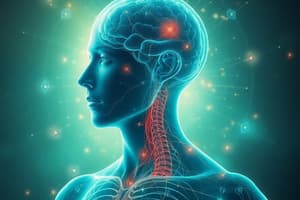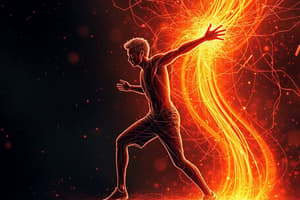Podcast
Questions and Answers
At what age should a baby typically be able to roll over and sit up without support?
At what age should a baby typically be able to roll over and sit up without support?
- Ten months
- Six months (correct)
- One month
- Eight months
Crawling typically develops before the ability to pull to stand.
Crawling typically develops before the ability to pull to stand.
True (A)
What is the final motor milestone typically reached by infants before they start walking independently?
What is the final motor milestone typically reached by infants before they start walking independently?
Standing independently
Around 12-13 months, a baby should be walking __________.
Around 12-13 months, a baby should be walking __________.
Match the following motor milestones with their typical ages:
Match the following motor milestones with their typical ages:
Which of the following skills typically requires postural control?
Which of the following skills typically requires postural control?
Postural control is fully developed by age 12 months.
Postural control is fully developed by age 12 months.
What are two specific types of changes in movement patterns that can predict the later diagnosis of Cerebral Palsy?
What are two specific types of changes in movement patterns that can predict the later diagnosis of Cerebral Palsy?
Infants develop their postural control by interacting with their _______ and refining their movements.
Infants develop their postural control by interacting with their _______ and refining their movements.
Match the age with the relevant postural control development milestone:
Match the age with the relevant postural control development milestone:
At what age do children typically start to show automatic postural control?
At what age do children typically start to show automatic postural control?
Infants learning to walk generally take about 2,368 steps and experience 17 falls per hour.
Infants learning to walk generally take about 2,368 steps and experience 17 falls per hour.
What are the three requirements for successful walking?
What are the three requirements for successful walking?
When infants begin walking independently, their stepping patterns are often __________.
When infants begin walking independently, their stepping patterns are often __________.
Match the stage of walking with its characteristics:
Match the stage of walking with its characteristics:
Flashcards
Immature postural system
Immature postural system
A postural system that is not fully developed, limiting the emergence of other behaviors.
Postural control maturity
Postural control maturity
Postural control typically matures between 10-12 years of age.
Motor milestones
Motor milestones
Specific skills related to movement, that typically appear at certain ages.
Infant skill acquisition
Infant skill acquisition
Signup and view all the flashcards
Reflex/Hierarchical Theory
Reflex/Hierarchical Theory
Signup and view all the flashcards
Systems Theory
Systems Theory
Signup and view all the flashcards
Independent sitting
Independent sitting
Signup and view all the flashcards
Head control
Head control
Signup and view all the flashcards
Reactive balance control
Reactive balance control
Signup and view all the flashcards
Anticipatory balance control
Anticipatory balance control
Signup and view all the flashcards
Sensory systems
Sensory systems
Signup and view all the flashcards
Cerebral Palsy
Cerebral Palsy
Signup and view all the flashcards
Reaching and Grasping
Reaching and Grasping
Signup and view all the flashcards
Supported locomotion
Supported locomotion
Signup and view all the flashcards
Independent walking
Independent walking
Signup and view all the flashcards
Visual guidance
Visual guidance
Signup and view all the flashcards
Sensory integration
Sensory integration
Signup and view all the flashcards
Cognitive resources
Cognitive resources
Signup and view all the flashcards
Dual-task situations
Dual-task situations
Signup and view all the flashcards
Stepping reflex
Stepping reflex
Signup and view all the flashcards
Development of Steady-State Gait
Development of Steady-State Gait
Signup and view all the flashcards
Running development
Running development
Signup and view all the flashcards
Locomotor rhythms
Locomotor rhythms
Signup and view all the flashcards
Study Notes
Postural Control and Development
- An immature postural system limits the emergence of other behaviors
- Postural control essentially matures by 10-12 years old
- Motor milestones, specific to age, mark typical development
- Infants can acquire functional skills in various orders and skip stages
- Not all infants will learn to crawl
Functional Skills that Require Postural Control
- Sitting
- Standing
- Walking unsupported
- Reaching forward
- Moving from sit to stand
Postural control: Reflex/Hierarchical Theory
- Reflects increasing maturity of cortical structures
Postural control: Systems Theory
- New skills emerge from the interaction of the child with the environment
- Postural control is a result of the interaction between body systems, including
- Muscle strength and changes in mass
- Motor coordination strategies
- Sensory systems
- Sensory strategies for organizing inputs
- Cognition
Development of Head Control and Independent Sitting
- Spontaneous movements in infants up to 6 months are complex, involving the whole body
- These movements vary in intensity, velocity, coordination, and fluidity
- Two specific changes in movement patterns are reliably predictive of a Cerebral Palsy diagnosis:
- Cramped synchronized general movements
- Absence of general movements of a fidgety character
- Head control in newborns is limited due to lack of organized muscle activity, not just strength
- Lack of head control in newborns results from lack of organized muscle activity, not just strength
- Steady-state balance is a dynamic process involving control of degrees of freedom in head and trunk
- Reactive balance control is refined as a child learns to sit independently
- Anticipatory balance control develops alongside improved trunk control and reach
- Sitting posture relies increasingly on visual systems, then somatosensory and vestibular cues
- Sensory systems work together to provide feedback and refine processing/movements
Development of Independent Stance
- Infants must learn to balance in reduced stability limits, control degrees of freedom, and recalibrate sensorimotor representations
- Strength is likely not a primary constraint
- Visual systems are actively employed in postural responses, while the somatosensory system matures more slowly
- Higher-level adaptive processes related to postural control are not fully mature by the time of independent walking
Refinement of Postural Control
- Children are shorter, closer to the ground and top-heavy, making balance more challenging
- The relative size of the head in younger children places the center of mass at about T12, compared to L5 to S1 in adults
- Children sway at a faster rate than adults
- At age 7, there is no correlation between body growth and sway during quiet stance
- Refinement of Reactive Postural Control:
- Postural responses in children are slower and more variable until 7-10 years old, then become more like adults
- Refinement of Anticipatory Postural Control:
- Children by 4-6 years of age have mature anticipatory postural adjustments before arm movements
- Refinement of Sensory Organization:
- Shift to somatosensory control of balance by 3 years old.
- Children 7-8 years old and younger show reduced ability to adapt senses for postural control when one or more senses are inaccurate
- Stability improves across all age groups through 14 years
Cognitive Systems in Postural Development
- Postural control requires attentional resources
- Younger children have fewer available resources, leading to greater difficulty with complex tasks
- Dual-task situations impact both postural and cognitive performance
Development of Steady-State Gait
- Infants average 2,368 steps and 17 falls per hour while learning to walk
- Infants practice walking in short, variable bouts in all directions
- To walk, a child must develop the ability to activate complex muscle contractions, control body segments, and compensate for shifts in the center of mass.
- They must also adapt their gait to changing tasks and environments
Prenatal Development
- Locomotor rhythms are seen in embryonic movements
- Isolated leg and arm movements develop in the embryo at about 9 weeks of age
- Alternating leg movements similar to walking movements seen after birth develop by 16 weeks of embryonic age
Steady-State Gait in the Newborn and Emergence of Independent Walking
- Locomotor behavior is constrained by immaturity of postural control system
- 7 phases of erect locomotion
- Stepping reflex
- Disappearance of stepping reflex
- The reappearance of stepping reflex
- Assisted locomotion
- Phases 5-7 are three phases of independent walking in which the hands gradually move from a high guarded position down to the side, and then the trunk and head become more erect
- Stepping becomes increasingly difficult to elicit during the first month of life, tending to disappear by about two months of age
Factors Contributing to Newborn Stepping and its Disappearance
- Reflex hierarchy perspective - newborn stepping results from stepping reflex and its disappearance is from inhibition by maturing higher neural centers
- Dynamic systems approach – locomotion is due to interacting complex processes, including sensory, motor, perceptual, respiratory, cardiac, and anatomical systems
Characterizing the Development of Steady-State Gait
- The emergence of walking with support is a result of maturation of the postural control system
- Joint movements in newborns transform from a synchronous pattern to an adult-like pattern by the end of the first year
- Adult-like gait patterns typically emerge during the latter part of the second year
Postural Control During the Emergence of Walking
- Characteristics of walking kinematics do not change until a child’s first unsupported steps, then they quickly mature
- Balance control and the stepping pattern continue to mature after the emergence of independent walking
Changes in Temporal Distance Factors During Early Walking
- Walking patterns are immature in the first independent walking attempts
- During the initial phase of walking, balance is learned
- The locomotor pattern progressively refines during a second phase
Requirements for Successful Walking
- Rhythmic stepping pattern
- Control of balance
- Ability to modify gait
Development Sequence of Walking: Characteristics of Mature Gait
- Duration of single-limb stance
- Walking velocity
- Cadence
- Step length
- Ratio of pelvic span to step width
Development Sequence for Walking: Initial Stage
- Difficulty maintaining upright posture
- Unpredictable loss of balance
- Rigid, halting leg action
- Short steps
- Flat-footed contact
- Toes turn outward
- Wide base of support
- Flexed knee at contact followed by quick leg extension
Development Sequence for Walking: Elementary Stage
- Gradual smoothing of pattern
- Step length increased
- Heel-toe contact
- Arms down to sides with limited swing
- Base of support within the lateral dimensions of trunk
- Out-toeing reduced or eliminated
- Increased pelvic tilt
- Apparent vertical lift
Development Sequence for Walking: Mature Stage
- Reflexive arm swing
- Narrow base of support
- Relaxed, elongated gait
- Minimal vertical lift
- Definite heel-toe contact
Development Sequence for Walking: Common Problems
- Inhibited or exaggerated arm swing
- Arms crossing midline of the body
- Improper foot placement
- Exaggerated forward trunk lean
- Arms flopping at sides or held out for balance
- Twisting of trunk
- Poor rhythmic action
- Landing flat-footed
- Flipping the foot or lower leg in or out
Development of Adaptation in Gait
- Development of Reactive Balance Strategies During Gait:
- Related to incorporating compensatory postural responses into the gait cycle
- Associated with increased stability and the ability to compensate for perturbations
- Stepping to recover balance
- Begins to develop in infants with 1-3 months of walking experience
- Refined by 6 months of walking experience
- Prior to losing balance, infants take reactive steps, bend their knees, hold onto nearby supports, and outstretch their arms to stop the fall. These responses are rapid, averaging less than a half a second after losing balance but before the body hits the ground, often with a combination of multiple behaviors.
- Development of Proactive Balance Strategies During Gait:
- Uses sensory information to modify gait patterns in advance of obstacles
- Obstacle Avoidance
- Initially steering with proactive movement of head and trunk
- Adjusting gait trajectory
- Depending more on visual input to guide locomotor strategy
Running Development
- Running differs from walking due to a flight phase.
- Children typically start running at 2 years old.
- Common mobility skills like hopping, galloping and skipping are evident by 4 years old.
- These developmental milestones are reliable indicators of balance development.
Typical Development: Contributions to Gait
- Vision contributes to gait by helping with environmental awareness such as identifying obstacles, and body orientation.
- Vestibular system plays a key role in balance and contributes to walking emergence.
- Head control is vital for gait control, and it can be achieved by using somatosensory, visual and vestibular information.
- Initially, children struggle with challenging movements but with more experience, they adjust.
- Cognitive development is evident during dual-tasking, as children begin to carry objects while walking.
- Cognitive load affects gait variability, where easier tasks result in less variability and vice versa.
- Children under 7 years old generally prioritize cognitive tasks over gait in dual-tasking scenarios.
- Cognitive tasks and gait are both impaired when crossing an obstacle in children under 7.
Development of Other Mobility Skills
- Rolling develops between 1-8 months.
- By 9 months, rolling patterns change from log-rolling to segmental rotation.
- Prone progression occurs in multiple phases, starting with lower extremity flexion and extension, and ending with organized movement during creeping.
- Supine-to-stand development involves rolling to prone, transitioning into all-fours, and eventually pulling to stand.
- Infants transition from flexed trunk and knees during sit-to-stand at 12-14 months to adult-like patterns by 9-10 years old.
Development of Reach, Grasp, and Manipulation
- Grasp reflex may develop separately from eye-hand coordination and is linked to postural control.
- Reaching emerges before grasping ability.
- Grasping develops around 4-5 months, and precedes exploration and manipulation.
- Prereaching movements, such as spontaneous waving or flapping, appear in the first year.
- Eye-head coordination enables infants to locate targets in space, and control involves visual, vestibular, and proprioceptive information.
- Eye-head coordination allows shifting gaze and disengaging from fixation by 4 months.
- Tracking objects in space improves from 6 weeks and by 5 months infants show predictive capabilities.
- Eye-head-hand coordination significantly develops after 4 months, with coupled movements by 2 months and postural stability by 4 months.
- Reaching and grasping skills refine over time, for example, pincer grasp emerges around 9-13 months.
Reach and Grasp Motor Components
- Prereaching is evident at birth, followed by reaching reduction and fisted hands by 2 months.
- Reaching becomes more integrated by 4 months, and often is bimanual.
- Unilateral reaching dominates by 6 months.
- Training intervention can improve reaching accuracy and smoothness in infants as young as 3.5 months.
- Childhood reaching involves smooth trajectories, consistent interjoint coordination, and reduced trunk displacement and variability.
- Visual control decreases with age, with 8-10-year-olds showing similarities to adult levels.
Reach and Grasp Sensory Components: Vision
- Visually guided reaching occurs as infants look at both hand and target.
- Visually triggered reaching involves looking at the target only.
- Visually guided reaching peaks at 7 months, replaced by visually triggered reaching.
- Visual feedback becomes unnecessary by 4-6 years, but this ability diminishes around age 7, increasing errors.
- Adults' levels of reaching accuracy are achieved around 10-11 years of age.
Development of Reach, Grasp and Manipulation: Grasp Development
- Four grasping patterns emerge in the first 5 months: fists, pre-precision grasps with varying digit postures, precision grips including pincer grasp, and self-directed grasps.
- Hand adjustments to the object become more precise with age.
- At 5-6 months, grasping is visually controlled, and the hand starts to close in anticipation of reaching.
- Hand opening becomes related to object size by 9-13 months.
- Palmer grasp is the initial grasp, with precision grip developing between the finger and thumb.
- Pincer grasp emerges around 10 months.
Anticipatory Control in Grasping and Lifting Objects
- Infants younger than 18 months show minor force variations when lifting different weights.
- Anticipatory control develops gradually with significant changes between 1-4 years.
- Adult levels are attained around 11 years old.
- Adjusting grip forces smoothly relies on external sensory information.
Reach and Grasp Cognitive Components: Object Exploration
- In-hand manipulation of objects develops over several years.
- Infants younger than a year engage in mouthing, waving, shaking, and banging.
- By 1 year infants understand how to use objects, and acquire skills requiring precision and object relationships.
- In the second year, infants understand how to use a spoon, and by the end of the second year, they can pretend to eat and drink.
Learning to Reach and Grasp for Moving Objects
- Infants as young as 18 weeks can catch objects moving at 30 cm/s.
- This involves predicting the future location of a flying object.
Reach and Grasp Cognitive Components: Dual-Task Contexts
- Dual-task costs for tracking skills are higher in young children.
- Adult levels are achieved at 15 years old.
- Faster reaction times in reaching tasks occur with maturation.
- Significant changes in reaction time occur until 8-9 years old.
- Adults' levels in reaction time are achieved by 16-17 years old.
Studying That Suits You
Use AI to generate personalized quizzes and flashcards to suit your learning preferences.
Description
Test your knowledge on the development of postural control and its impact on motor skills in infants. This quiz covers key concepts including the maturation timeline and the theories behind postural control. Understand how various body systems contribute to functional skills like sitting, standing, and walking.




